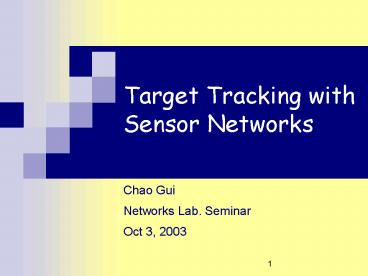Target Tracking with Sensor Networks - PowerPoint PPT Presentation
1 / 19
Title:
Target Tracking with Sensor Networks
Description:
Frisbee: A Networks Model for Target Tracking Applications ... the Frisbee boundary. Each node autonomously decide if it is in the current Frisbee. Adaptive ... – PowerPoint PPT presentation
Number of Views:198
Avg rating:3.0/5.0
Title: Target Tracking with Sensor Networks
1
Target Tracking with Sensor Networks
- Chao Gui
- Networks Lab. Seminar
- Oct 3, 2003
2
Agenda
- Background
- Frisbee A Networks Model for Target Tracking
Applications - A Cooperative Tracking Algorithm
- Performance Study
3
Wireless sensor networks
- Wireless sensor node
- power supply
- sensors
- embedded processor
- wireless link
- Many, cheap sensors
- wireless ? easy to install
- intelligent ? collaboration
- low-power ? long lifetime
4
Taxonomy of Sensor Networks
- SN Characteristics
- Sensor
- Observer
- Phenomenon
- SN Architecture
- Infrastructure sensors their deployment
(density, location, etc) - Network Protocol communication between sensors
and observer(s) - Application/Observer translation between
observer interest and network level
implementation
5
Taxonomy of Sensor Networks
- Communication Models
- Information delivery dissemination of interests
delivery of interested data - Infrastructure comm. needed to configure,
maintain and optimize - Data Delivery Models
- Continuous
- Event-driven
- Observer-initiated
- Network Dynamics Models
- Mobile observer
- Mobile sensor
- Mobile phenomenon
6
Agenda
- Background
- Frisbee A Networks Model for Target Tracking
Applications - A Cooperative Tracking Algorithm
- Performance Study
7
Frisbee A Networks Model for Target Tracking
Applications
- Extend network life-time with given energy
resource. - Interesting events happen infrequently, and
only take place at certain locations. - Make the sensors sleep during the long interval
of inactivity. - When and where event occurs, only a limited zone
of network is kept in full active state. - For moving target, the active zone moves along.
8
Frisbee A Networks Model for Target Tracking
Applications
9
Issues with Frisbee Model
- Power savings with wake-up
- Can be waked up by neighbors
- Be able to form a wakeup wavefront that
precedes the target - Localized algorithm for defining the Frisbee
boundary - Each node autonomously decide if it is in the
current Frisbee - Adaptive fidelity
10
Agenda
- Background
- Frisbee A Networks Model for Target Tracking
Applications - A Cooperative Tracking Algorithm
- Performance Study
11
Cooperative Tracking with SN
- Tracking identify an object and determine its
path over a period of time. - Advantages
- Easy deployment
- Track multiple targets simultaneously
- Difficulties
- Very limited resources
- Work with local information
- Timeliness of sensor data
12
A Cooperative Tracking Algorithm
- Sensor detection model
- Object always detected in rage R-e
- Object never detected out of range Re
- Object possibly detected in range R-e, Re
- e 0.1R
- Comments
- Binary detection model is most simple and
reliable. Traditional algorithms rely - on more sophisticated model determining the
distance by AOS/AOA. - Location resolution is the sensing range for one
sensor, however, by combining - multiple sensors, resolution is improved
significantly. - The sensing range dont have to be circular.
13
A Cooperative Tracking Algorithm
- When the object enters the region where multiple
sensors can detect it, its position is within the
intersection of the overlapping sensing ranges. - Algorithm
- Each node records the duration for which the
object is in its range. - Neighboring nodes exchange these times and their
locations. - For each point of time, the objects estimated
position is computed as the weighted average of
the detecting nodes locations. - A line fitting algorithm is run on the resulting
set of points.
14
A Cooperative Tracking Algorithm
- Weight assignment
- Sensitive, affect the accuracy of tracking
- Possible ways
- Equal weight Estimated object position is at
the centroid of the sensing nodes locations - Weight according to the distances to the object
- The sensing node closer to the object should have
higher weight
15
A Cooperative Tracking Algorithm
Observation Sensors that are closer to the path
of the target will stay in sensor range for a
longer duration.
16
A Cooperative Tracking Algorithm
- Better weights
- Proportional weight.
- Logarithmic weight.
17
Agenda
- Background
- Frisbee A Networks Model for Target Tracking
Applications - A Cooperative Tracking Algorithm
- Performance Study
18
Simulation Results
100 sensors. Target moving in straight line with
speed 1 R/s.
19
References
- S. Tilak, N.B. Abu-Ghazaleh, W. Heinzelman, A
Taxonomy of Wireless Micro-Sensor Network
Models, Mobile Computing and Communications
Review, Vol. 6, No. 2. - A. Cerpa, J. Elson, M. Hamilton, J. Zhao,
Habitat Monitoring Application Driver for
Wireless Communications Technology, First ACM
Sigcomm Workshop on Data Communications in Latin
America and the Caribbean, Apr. 2001 - K. Mechitov, S. Sundresh, Y. Kwon, G. Agha,
Cooperative Tracking with Binary-Detection
Sensor Networks, Technical Report
UIUCDCS-R-2003-2379, Computer Science, UIUC,
Sept. 2003































